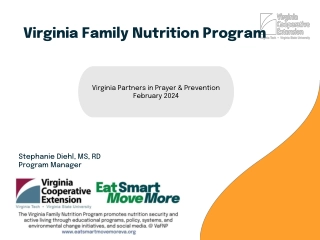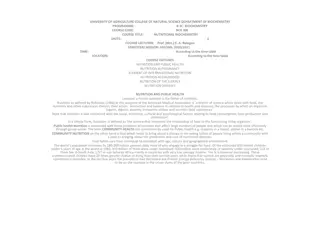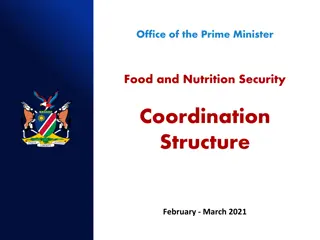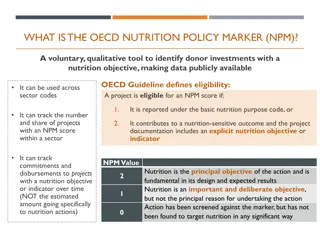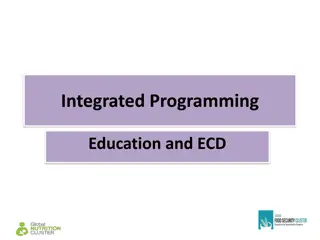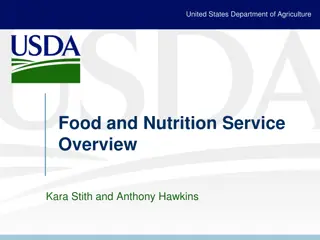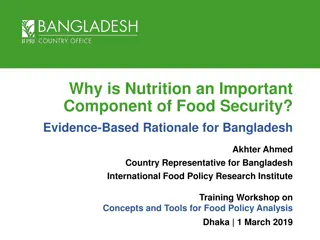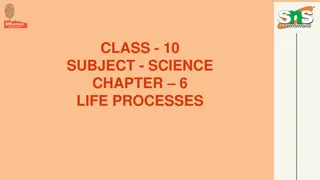Understanding Food Nutrition and Health Essentials
This content provides valuable information on nutrients, their functions in the body, food sources, and the effects of deficiencies. It covers macronutrients like fat, protein, and carbohydrates, as well as micronutrients such as minerals and vitamins. Explore the importance of nutrients like Vitamin A, Vitamin B, Vitamin C, Vitamin D, iron, calcium, and sodium in maintaining overall health. Learn about the sources of these nutrients, their benefits, and potential consequences of deficiencies.
Download Presentation

Please find below an Image/Link to download the presentation.
The content on the website is provided AS IS for your information and personal use only. It may not be sold, licensed, or shared on other websites without obtaining consent from the author. Download presentation by click this link. If you encounter any issues during the download, it is possible that the publisher has removed the file from their server.
E N D
Presentation Transcript
Food Nutrition & Health Food Nutrition & Health Student Name: Class: Target Level:
Nutrient Function in the body Macro nutrients Food source Fat Protein Carbohydrate (Starch/sugar/Fibre or NSP) Micro nutrients Minerals Iron Calcium Sodium Vitamins Vitamin A Vitamin B Vitamin C Vitamin D
CHALLENGE Nutrient Why we need it (function) Food it is in (sources) Macro nutrients Effect of deficiency Insulates the body (keep it warm). Protect organs liver, kidney Gives energy Provides Fat soluble Vits A,D,E and K Animal (saturated) fat lard, butter Vegetable (unsaturated) oil, margarine Too much saturated fat, leads to high cholesterol which could lead to heart disease. FAT Growth and Repair of ALL cells in our body. A source of energy. For the production of enzymes. (HBV High Biological value LBV Low Biological value) Sugar-simple carb for quick release energy. Starch-complex carb for slow release energy. Fibre helps digestion Made of Amino Acids Animal (HBV) meat, fish, egg, dairy foods Vegetable (LBV) nuts, beans, lentils, quorn. PROTEIN CARBOHY- DRATE Starch pasta, rice, potato Fibre (NSP) - fruit/veg, whole-wheat bread, rice, pasta. Sugar sugar, honey, fruit.
VIT A Eye sight in dim light. Healthy immune system Carrot & other yellow/red/orange fruit or veg. Egg, milk, cheese. Liver, oily fish. B1 B2 B3 Folic acid Cereal, milk, egg. Meat, green leafy veg. Micro nutrients VIT B To release energy from food. Healthy nervous system VIT C Heal wounds, fight infection. Helps the body absorb iron. Orange, lemon, green veg, Potato, tomatoes, peppers. Works with Calcium to build strong bones/teeth. Dairy food, cereals, oily fish, eggs, liver, Sunshine. VIT D Healthy red blood cells to prevent anaemia. Red meat, liver, green veg. IRON Beans, wholegrain cereal. Strong bones and teeth. For the clotting of blood. Dairy food, green veg, nuts. CALCIUM Maintains fluid levels in the body. Salt. Added to bacon, cheese Crisps. SODIUM (in salt) CHALLENGE Effect of deficiency Regulate body temperature & prevent dehydration. Tap water, fruit/veg. WATER
Nutrient Fat Function in the body Food source Gives energy & insulates the body (keep it warm). Protect organs liver, kidney Deficiency weight loss/cold Growth. Repair of cells. A source of energy. (HBV High Biological value LBV Low Biological value) Deficiency- lack of growth For energy. Sugar is a simple carb for quick release. Starch is a complex carb for slow release energy. Fibre helps digestion, prevents constipation, bowel cancer Deficiency- lack of energy, bowel disorders Animal (saturated) fat lard, butter Vegetable (unsaturated) oil, margarine Animal (HBV) meat, fish, egg Vegetable (LBV) nuts, beans, lentils, quorn, cereals Protein Amino Acids Carbs Starch Sugar Fibre(NSP) Starch pasta, rice, potato, cereals Fibre (NSP) - fruit/veg, whole-wheat bread, rice, pasta, cereals. Sugar sugar, honey, fruit. Minerals Iron Red meat, liver, green veg. Healthy red blood cells Deficiency- anaemia. Calcium Strong bones and teeth. Deficiency- lack of growth SodiumMaintain fluid levels in body. Deficiency- muscle cramp, dizzy Dairy food, green veg, nuts. Salt.Added to bacon, cheese Crisps. Vitamins Vit A Eye sight in dim light, immune systme. Deficiency- night blindness Fat soluble Vit B To release energy from food. Healthy nervous system Deficiency- fatigue, B12 spina bifida in babies Water soluble Vit C Heal wounds, fight infection, help absorb iron. Def bleeding, bruising, muscle pain Water soluble Vit D Works with Calcium to build strong bones/teeth. Deficiency- bone & muscle pain Water soluble Carrot, tomato, egg, milk, cheese. B1 B2 B3 Folic acid Cereal, milk, meat. Orange, lemon, green veg, potato. Dairy food, cereals. Sunshine.
Effects of Deficiency: Use the table to explain what Effects of Deficiency: Use the table to explain what happens if you have too much or not enough .. happens if you have too much or not enough .. Vitamin / Mineral Deficiency / Excess Vitamin A Vitamin D Vitamin E Vitamin K Vitamin B1 Vitamin B2 Folate Vitamin B12 Vitamin C
Nutrients Homework Nutrients Homework Using the information in the tables, produce a set of revision/flash cards to help you learn the information. Test in class next lesson
Leads to.. Obesity Tooth decay Risk of diabetes How to change diet to prevent this Use sweeteners Replace sugar in a recipe with dried fruit Put a bit less sugar in the recipe Too much sugar Too much fat High cholesterol Blocked arteries Heart disease. Obesity Use reduced fat spread, cheese, sausages etc Cut fat off meat e.g. rind off bacon Grill, boil or bake rather than fry Too much salt High blood pressure which puts a strain on the heart. Replace salt with herbs Use a bit less salt in a recipe Eat less salty foods nuts, bacon or buy a Low salt version. Too little fibre Constipation Diverticular disease Risk of bowel cancer Eat more fruit and veg especially skins. Switch to wholemeal bread, pasta, rice. Increase insoluble fibre intake
1. Name 1 animal and 1 vegetable source of protein. Animal ___________ Vegetable ___________ (2) 2. State two functions of protein in the body. (2) .. . .. .. .. Different protein foods complement each other. Explain what is meant by complementation of protein and why it can be beneficial to include a mixture of protein foods in the diet. (6 marks) . . .. . .. . .. . .. . .. . .. . .. . .. . .. . .. . .. . .. . .. . ..
1. Animal meat, fish, egg, dairy food Vegetable Lentil, bean, soya, Quorn, tofu 2. State two functions of protein in the body. Growth/ muscle strength Repair Secondary source of energy/ provides energy/ more energy 3. Different protein foods complement each other. Explain why it can be beneficial to include a mixture of protein foods in the diet. HBV animal source, contains essential amino acids, e.g. meat, fish, milk, cheese, eggs LBV vegetable/ plant source, do not contain all essential amino acids, e.g. cereals, pulses, nuts Specific examples of how protein foods complement each other, e.g. beans on toast, lentil soup with bread, vegetable curry with rice Specific reference to soya (containing HBV) and gelatine (containing LBV) Reference to one amino acid making up for the loss of or compensating for another in two specific protein foods Reference to cost Marks may be awarded for reference to general function of proteins in the diet maximum 2 marks. Award 0 2 marks for a basic response which makes little reference to complementary action of proteins Award 3 4 marks for a good response with examples. Writing is structured, fit for purpose, reasoned and clearly expressed. Specialist vocabulary is correct. Award 5 6 marks for an excellent response with specific examples. Writing is well-structured, fit for purpose, clearly expressed. Specialist vocabulary is used appropriately.
Discuss reasons why individuals should include complex carbohydrates and foods that have a high dietary fibre (NSP) content in their daily diets. [10] . . .. . .. . .. . .. . .. . .. . .. . .. . .. . .. . .. . .. . .. . .. . . .. . .. . .. . .. . ..
Examples may be used to exemplify points made Complex carbohydrates: potatoes, bread, cereals, rice and pasta Whole grain ingredients brown rice buckwheat bulgur millet oatmeal quinoa rolled oats whole-grain barley whole-grain corn whole oats whole rye whole wheat wild rice Whole grain products/examples of dishes: this list is by no means exhaustive whole-wheat bread instead of white bread (wholemeal) brown rice instead of white rice whole-wheat pasta use whole grains in mixed dishes, such as barley in vegetable soup or stews and bulgur wheat in casserole or stir-fries substitute whole wheat or oat flour for up to half of the flour in pancakes, waffles, muffins or other flour- based recipes use whole-grain bread or savoury biscuits in meatloaf. try rolled oats or a crushed, unsweetened whole grain cereal as breading for baked chicken, fish, veal cutlets try an unsweetened, whole grain ready-to eat cereal as croutons in salad
Food Nutrition & Health: Making informed Food Nutrition & Health: Making informed Choices Choices The Eatwell Guide shows the proportions of food groups that should be eaten daily in a well-balanced diet. What are the 8 current guidelines for a Healthy diet? 1. 2. 3. 4. 5. 6. 7. 8.
Special diets Outline your knowledge and understanding of the following health conditions. Diabetic type 2 Bowel cancer Obesity Coronary Heart Disease Lactose intolerant Coeliac Iron Deficiency Anaemia Dental Health Osteoporosis Vegetarian lacto-ovo, lacto, vegan,
We all need energy from food to keep us alive. Discuss why people have different energy needs. What 3 (or 4) points would you include? How would you explain each? 6 marks What examples would you give?
Age Energy input should be greater than energy out put in children. Older people: tend to use less energy as metabolism slows down due to reduced physical activity. Gender/Sex Males tend to use more energy than females as they are bigger and have more muscle tissue. State of the body Pregnancy needs extra energy for the growth of the baby. Energy input should be greater than energy out put. Lactation needs extra energy for the production of milk. Illness and after operations the metabolism may be reduced due to less physical activity. Physical activity/occupation People who have physically demanding jobs or take lots of exercise use more energy than people who sit down all day. energetic jobs like builders or athletes need more energy from their food compared to office workers Basic Metabolic Rate This is the rate we burn up calories and it differs with each person. BMR is high in times of growth. It is affected by, body size, shape, weight, sex, age, rate of growth, amount of sleep, and state of nutrition.
Discuss why nutritional requirements change at different life stages PEE . ... .. . ... . . ... .. . ... . . ... . ... . ... . ... . ... . ... [8]
Discuss why nutritional requirements change at different life stages (8). Point Explain Example/evidence Nutritional needs Baby Protein growth. Calcium bones/teeth Milk provides all nutrients needed for first 4 months No salt/sugar should be added Calories/Carbs needed to support activity levels Pasta, rice Higher protein - growth meat, egg, dairy Higher protein - growth meat, egg, dairy Iron esp. girls for red blood cells liver Calcium for bone development due to growth dairy food, green veg Less Carbs/Calories less active and not growing. Will vary with job. Less fatty and sugary foods Still need correct balance of Vits/Minerals e.g.s could be given Children Teens Adults Elderly Lower Cals much less active High calcium prevent osteoperosis (weakening of bones) dairy, nuts, green veg Extra Fibre (NSP) constipation can be an issue fruit, veg, whole grains Pregnancy Folic acid develop nervous system, cereals iron, red meat, liver, green veg ensure balanced diet esp. if breastfeeding
Quick Quiz Give three recommended guidelines for a healthy diet. Why is a good supply of folate (folic acid) needed in early pregnancy? In babies, what is the introduction of solid foods called? What is osteoporosis?
Food, Nutrition & Health Homework Food, Nutrition & Health Homework 1) Explain why eating a healthy, balanced diet and being physically active are both important in the prevention and treatment of obesity. Give reasons & examples in your answer. 20 marks 2) a) explain why it is important not to eat lots of sugary snacks & sweetened soft drinks in between meals. 5 marks b) outline the advice you would give to a child to encourage them to care for their teeth. 5 marks
British & International Cuisine British & International Cuisine Traditional British food makes use of the ingredients produced in the local area e.g. cheeses. Cheddar (Somerset) Wensleydale (Yorkshire) Red Leicester, Double Gloucester. Each cheese has its own distinctive flavour & texture & is made using ingredients from its region of origin. Name two other British cheeses not mentioned here:
British Food British Food List some British regional foods here e.g. Cornish pasty Why was the Cornish pasty invented & why does it have a crimped edge?
Modern British food Modern British food We now live in a multicultural country. Explain, with examples how this has influenced modern British food.
Other Cuisines. Homework Task Other Cuisines. Homework Task Tapas & Paella are traditional Spanish foods. Explain what they are and give examples using words and pictures. Japan: Fish, Noodles & Rice. Research the most common Japanese foods. Explain the specific types of fish, rice & noodles + dishes made with them. What is sushi & sashimi? What is the difference between the two?
"Dietary fat recommendations in the spotlight" Despite individuals following advice and reducing the amount of total fat in their diets, many are still experiencing health issues. This has caused current guidelines to be questioned. (adapted from British Nutrition Foundation, February 2015.) (b) Evaluate the impact on health of reducing the amount of saturated fat in the diet. [6]
Reducing the amount of saturated fat in the diet will have a positive impact on health because: too much saturated fat can be linked to high blood cholesterol- too much cholesterol in the blood deposited on walls of arteries causes them to narrow restricting blood flow and making them less efficient which can lead to a heart attack and if severe can cause death excess saturated fat is linked to coronary heart disease (CHD) hence by reducing saturated fat intake the risk of CHD is reduced. too much is linked to obesity (excessive fatness measured as a ratio of weight to height), which causes additional physical and emotional risks to health too much saturated fat can cause weight gain/obesity which can cause strain on joints/heart/ lead to mobility problems too much saturated fat is also linked to diabetes: glucose in blood stream not being balanced correctly reducing the amount of saturated fat eaten will ensure no excess fat is stored in the liver which could reduce the risk of poor liver function and liver disease may reduce the chance of cancer (there has been some connections made between eating too much saturated fat and bowel/breast cancer but evidence is limited, however there are links between obesity and cancers such as bowel, pancreatic, uterus and kidneys) Candidates may refer to examples of saturated fats within their responses. saturated fat is found in butter and lard, pies, cakes and biscuits, fatty cuts of meat, sausages and bacon, and cheese and cream


